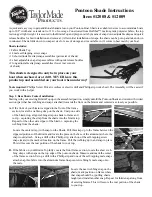
7
5. Functional characteristics
5.1 Ground
The ground switch separates signal ground from
protective ground to prevent unwanted humming
from possibly occuring ground loops.
5.2 Master
Adjust the overall volume with the volume control,
the clip LED shows a possible overload in the
three inputs, the power-LED indicates operational
readiness.
5.3 EQ
The dual-band equalizer provides you with an
active and high quality sound interaction tool for
an accentuated high- or low-frequency-modulation
through the treble and bass controls.
5.4 Aux in
Stereo input socket for additional signal sources
(e.g. for CD player).
5.5 Mic in
Microphone input with combo socket (XLR-female
plus 6.3 mm jack socket), the XLR socket is equip-
ped with 48V phantom power.
(s. General Note:
„Use of phantom power“ on this page)
5.6 Line in
Input for line level sources (6.3 mm jack socket),
factory provided phantom power is not activated.
If required, 9V-phantom power can additionally be
activated in this input by an internal jumper.
Please note: For this alteration the device must be
opened, therefore only qualified service person-
nel may carry out modifications concerning the
de-/activating of phantom power.
After the activation, devices that require 9V-
phantom power may be connected to this input via
stereo jackplug. The phantom power supply will be
indicated by the related LED.
(s. General Note: „Use
of phantom power“ on this page)
General Note: Use of 48V or 24V phantom power
(Phantom power = remote supply, here: powering
an audio device via the connected audio line)
Turn on the phantom power only if the unit connec-
ted to an XLR socket is designed to handle it!
In general, suitable units are e.g. condenser
microphones, active DI-boxes and other special
audio devices, whose power supply is drawn from
the phantom power. Such devices are also labelled
accordingly; please heed the permissible power
consumption (max.10mA).
High-quality dynamic microphones with a balanced
signal need no phantom power, but can handle it
anyway.
Other devices, which have not been designed
explicitly for phantom power operation, can suffer
from considerable malfunctions and damage may
result as well.
Examples of devices that may be damaged by
incorrect application of phantom power include:
Low-cost dynamic microphones with a mono jack-
plug (unbalanced signal) that were fitted afterwards
with an XLR connector.
Audio devices with a balanced XLR output (e.g.
DI-boxes, effects devices, instrument preamps with
a DI output etc.) which are not protected against
phantom power applied to their XLR output. (The
DI connectors on AER products are protected
against applied phantom power.)
Other audio devices (such as preamps, effects
pedals etc.) whose unbalanced line output was
replaced by an XLR socket.
If in doubt please consult the manufacturer of the
device you are using.
Содержание AG 82
Страница 1: ...1 AG 82 active monitor user manual ...
Страница 9: ...9 9 www aer music de AG 82 active monitor 2012_10_GB ...



























